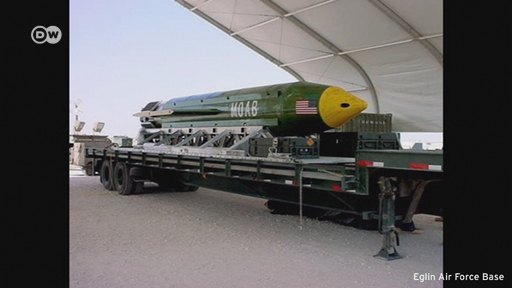After its deployment in Afghanistan, the Massive
Ordinance Air Blast is the largest conventional bomb ever to be used in
combat. It relies on a different type of mechanism to pack such a big
punch.
- Most bombs
are a mix of "fuel" - to drive the explosion - and an oxidizer that the
fuel can burn with. The Mother of All Bombs - Massive Ordinance Air
Blast (MOAB) is different. It's a thermobaric weapon, meaning that it
can use the oxygen in the air at the detonation site. Because there's no
oxidizer, the bomb can carry more of the explosive fuel component.
Read: US drops largest non-nuclear bomb on 'IS' target in Afghanistan - Normal bombs explode out from a small area. Thermobaric bombs like the MOAB scatter the explosive fuel like an aerosol, making it possible for them to ignite the surrounding atmosphere. "What it does is basically suck out all of the oxygen and lights the air on fire," Bill Roggio, of the Foundation for Defence of Democracies think tank, told the newspaper Air Force Times. "It's a way to get into areas where conventional bombs can't reach."
- For military purposes, the GBU-43/B MOAB replaced the "daisy cutter," an air burst weapon that could be used to clear vegetation for helicopter landing sites during the Vietnam War.
- Instead of being dropped through normal bomb bay doors, the heavy MOAB is pushed out of a cargo plane on a pallet. It then accelerates rapidly to its terminal velocity. The GBU-43/B is directed by a satellite guidance system and fins, making it one of the world's largest "smart" bombs.
- The MOAB would normally explode about 6 feet (1.8 meters) above the ground and measures 9 meters (30 feet) in length). It is about a meter wide and weighs 9,500 kilograms (21,000 pounds), about twice the weight of the Little Boy atomic bomb dropped on Hiroshima.
- Its casing is thin, to ensure the maximum blast is transmitted. The MOAB can clear out trees in a 150 meter diameter.
- The explosive fuel is Tritonal, a mixture of four parts TNT to one part aluminum powder. The aluminum increases the destructive power the TNT would have on its own by almost 20 percent.
- According to according to the military equipment site Deagel.com, One MOAB costs about $16 million, and 20 have been produced. That's about $320 billion so far - although this was widely shared via social media as the amount for one bomb.
- The MOAB was first tested on 11 March 2003 at Eglin Air Force Base in Florida.
- The Russians have developed a weapon known as the "Father of All Bombs." Although smaller, a higher temperature at the blast center is purported to make it four times more powerful than the MAOB.
- With just 11 metric tons of TNT, the Afghanistan MOAB detonation is much smaller than other big non-nuclear explosions in history. In December 1917, the SS Imo and SS Mont Blanc collided in the harbor of Halifax, Nova Scotia. The resultant blast was about 2.9 kilotons (equivalent to 2,900 metric tons of TNT). It would require about 250 MOAB blasts to equal the Halifax explosion. In 1947, British engineers tried to destroy submarine facilities on the North Sea island of Helgoland - which had been used as a base for German U-boats - in an operation known as the "British Bang." The island survived the 3.2 kiloton blast, but with significant damage.

